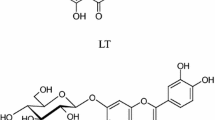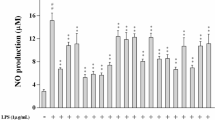Abstract
Cephalonoplos segetum has been used as an herbal remedy, and is considered to have anti-inflammatory potential. However, its biological mechanism in this treatment process remains unknown. Therefore, the anti-inflammatory activity of the ethyl acetate fraction of C. segetum extracts (CSE-EA), more active than C. segetum extracts (CSE) in murine macrophages, was investigated. Production levels of nitric oxide (NO), prostaglandin E2 (PGE2), tumor necrosis factor-α (TNF-α), and interleukin-1β (IL-1β) by lipopolysaccharide (LPS)-induced RAW 264.7 macrophages were measured by ELISA. In addition, protein expression levels of inducible NO synthase (iNOS) and cyclooxygenase (COX)-2, and the phosphorylation of mitogenactivated protein kinases (MAPKs) in the LPS-induced macrophages were investigated by Western blotting. The CSE-EA (50, 100 or 200 μg/mL) significantly inhibited NO, PGE2, TNF-α, and IL-1β production in LPS-induced macrophages in a dose-dependent manner with 50% inhibitory concentration values of 80.4, 104.7, 91.3, and 46.7 μg/mL, respectively. Similarly, CSE-EA reduced protein expression of iNOS and COX-2 and led to the attenuated activation of kinases ERK1/2 and JNK in the macrophages. Results of the present study suggest that the anti-inflammatory effects of CSE-EA are likely due to the down-regulation of NO, PGE2 TNF-α, and IL-1β and the reduced expression of iNOS and COX-2 via suppression of MAPK signaling pathways in LPS-induced murine macrophages.
Similar content being viewed by others
References
Baumann H and Gauldie J (1994) The acute phase response. Immunol Today 15, 74–80.
Cheon MS, Yoon T, Lee do Y, Choi G, Moon BC, Lee AY, Choo BK, and Kim HK (2009) Chrysanthemum indicum Linné extract inhibits the inflammatory response by suppressing NF-kappaB and MAPKs activation in lipopolysaccharide-induced RAW 264.7 macrophages. J Ethnopharmacol 122, 473–477.
Dinarello CA (2004) Infection, fever, and exogenous and endogenous pyrogens: Some concepts have changed. J Endotoxin Res 10, 201–222.
Fujiwara N and Kobayashi K (2005) Macrophages in inflammation. Curr Drug Targets Inflamm Allergy 4, 281–286.
Green LC, Wagner DA, Glogowski J, Skipper PL, Wishnok JS, and Tannenbaum SR (1982) Analysis of nitrate, nitrite, and [15N]nitrate in biological fluids. Anal Biochem 126, 131–138.
Guastadisegni C, Nicolini A, Balduzzi M, Ajmone-Cat MA, and Minghetti L (2002) Modulation of PGE2 and TNF-α by nitric oxide in resting and LPS-activated RAW 264.7 cells. Cytokine 19, 175–180.
Heo BG, Chon SU, Park YJ, Bae JH, Park SM, Park YS, Jang HG, and Gorinstein S (2009) Antiproliferative activity of Korean wild vegetables on different human tumor cell lines. Plant Foods Hum Nutr 64, 257–263.
Hinz B and Brune K (2002) Cyclooxygenase-2–10 years later. J Pharmacol Exp Ther 300, 367–375.
Johnson GL and Lapadat R (2002) Mitogen-activated protein kinase pathways mediated by ERK, JNK, and p38 protein kinases. Science 298, 1911–1912.
Kaminska B (2005) MAPK signalling pathways as molecular targets for antiinflammatory therapy-from molecular mechanisms to therapeutic benefits. Biochim Biophys Acta 1754, 253–262.
Kundu JK and Surh YJ (2005) Breaking the relay in deregulated cellular signal transduction as a rational for chemoprevention with anti-inflammatory phytochemicals. Mutat Res 591, 123–146.
Kundu JK and Surh YJ (2008) Inflammation: Gearing the journey to cancer. Mutat Res 659, 15–30.
Lange M, Hamahata A, Traber DL, Nakano Y, Traber LD, and Enkhbaatar P (2011) Specific inhibition of nitric oxide synthases at different time points in a murine model of pulmonary sepsis. Biochem Biophys Res Commun 404, 877–881.
Lee SU, Choi YH, Kim YS, Min YK, Rhee M, and Kim SH (2010) Antiresorptive saurolactam exhibits in vitro anti-inflammatory activity via ERK-NF-kappaB signaling pathway. Int Immunopharmacol 10, 298–303.
Ljung T, Lundberg S, Varsanyi M, Johansson C, Schmidt PT, Herulf M, Lundberg JO, and Hellstrom PM (2006) Rectal nitric oxide as biomarker in the treatment of inflammatory bowel disease: Responders versus nonresponders. World J Gastroenterol 12, 3386–3392.
Lundberg IE (2000) The role of cytokines, chemokines, and adhesion molecules in the pathogenesis of idiopathic inflammatory myopathies. Curr Rheumatol Rep 2, 216–224.
McCann SM, Mastronardi C, de Laurentiis A, and Rettori V (2005) The nitric oxide theory of aging revisited. Ann N Y Acad Sci 1057, 64–84.
Murakami A (2009) Chemoprevention with phytochemicals targeting inducible nitric oxide synthase. Forum Nutr 61, 193–203.
Niiro H, Otsuka T, Ogami E, Yamaoka K, Nagano S, Akahoshi M, Nakashima H, Arinobu Y, Izuhara K, and Niho Y (1998) MAP kinase pathways as a route for regulatory mechanisms of IL-10 and IL-4 which inhibit COX-2 expression in human monocytes. Biochem Biophys Res Commun 250, 200–205.
Park HJ, Han ES, Park DK, Lee C, and Lee KW (2010) An extract of Phellinus linteus grown on germinated brown rice inhibits inflammation markers in RAW264.7 macrophages by suppressing inflammatory cytokines, chemokines, and mediators and up-regulating antioxidant activity. J Med Food 13, 1468–1477.
Rao KM, Meighan T, and Bowman L (2002) Role of mitogen-activated protein kinase activation in the production of inflammatory mediators: differences between primary rat alveolar macrophages and macrophage cell lines. J Toxicol Environ Health A 65, 757–768.
Schwartsburd PM (2003) Chronic inflammation as inductor of pro-cancer microenvironment: Pathogenesis of dysregulated feedback control. Cancer Metastasis Rev 22, 95–102.
Shiga M, Nishina K, Mikawa K, and Obara H (2001) The effects of lidocaine on nitric oxide production from an activated murine macrophage cell line. Anesth Analg 92, 128–133.
Southan GJ and Szabo C (1996) Selective pharmacological inhibition of distinct nitric oxide synthase isoforms. Biochem Pharmacol 51, 383–394.
Tunctan B and Altug S (2004) The use of nitric oxide synthase inhibitors in inflammatory disease; a novel class of anti-inflammatory agents. Curr Med Chem 3, 271–301.
Vasto S, Candore G, Balistreri CR, Caruso M, Colonna-Romano G, Grimaldi MP, Listi F, Nuzzo D, Lio D, and Caruso C (2007) Inflammatory networks in ageing, age-related disease and longevity. Mech Ageing Dev 128, 83–91.
Wahl SM, McCartney-Francis N, Chan J, Dionne R, Ta L, and Orenstein JM (2003) Nitric oxide in experimental joint inflammation: Benefit or detriment? Cells Tissues Organs 174, 26–33.
Yoon T, Cheon MS, Lee AY, Lee do Y, Moon BC, Chun JM, Choo BK, and Kim HK (2010) Anti-inflammatory activity of methylene chloride fraction from Glehnia littoralis extract via suppression of NF-kappa B and mitogen-activated protein kinase activity. J Pharmacol Sci 112, 46–55.
Zhang Y and Dong C (2005) MAP kinases in immune responses. Cell Mol Immunol 2, 20–27.
Author information
Authors and Affiliations
Corresponding author
Additional information
M. S. Cheon’s present address: Biotechnology Examination Division, Chemistry and Biotechnology Examination Bureau, Korean Intellectual Property Office, Republic of Korea
Rights and permissions
About this article
Cite this article
Chun, J.M., Cheon, M.S., Park, M. et al. Inhibitory effects of an ethyl acetate fraction from Cephalonoplos segetum on inflammatory mediators from lipopolysaccharide-induced RAW 264.7 macrophages. J Korean Soc Appl Biol Chem 55, 41–46 (2012). https://doi.org/10.1007/s13765-012-0007-2
Received:
Accepted:
Published:
Issue Date:
DOI: https://doi.org/10.1007/s13765-012-0007-2




